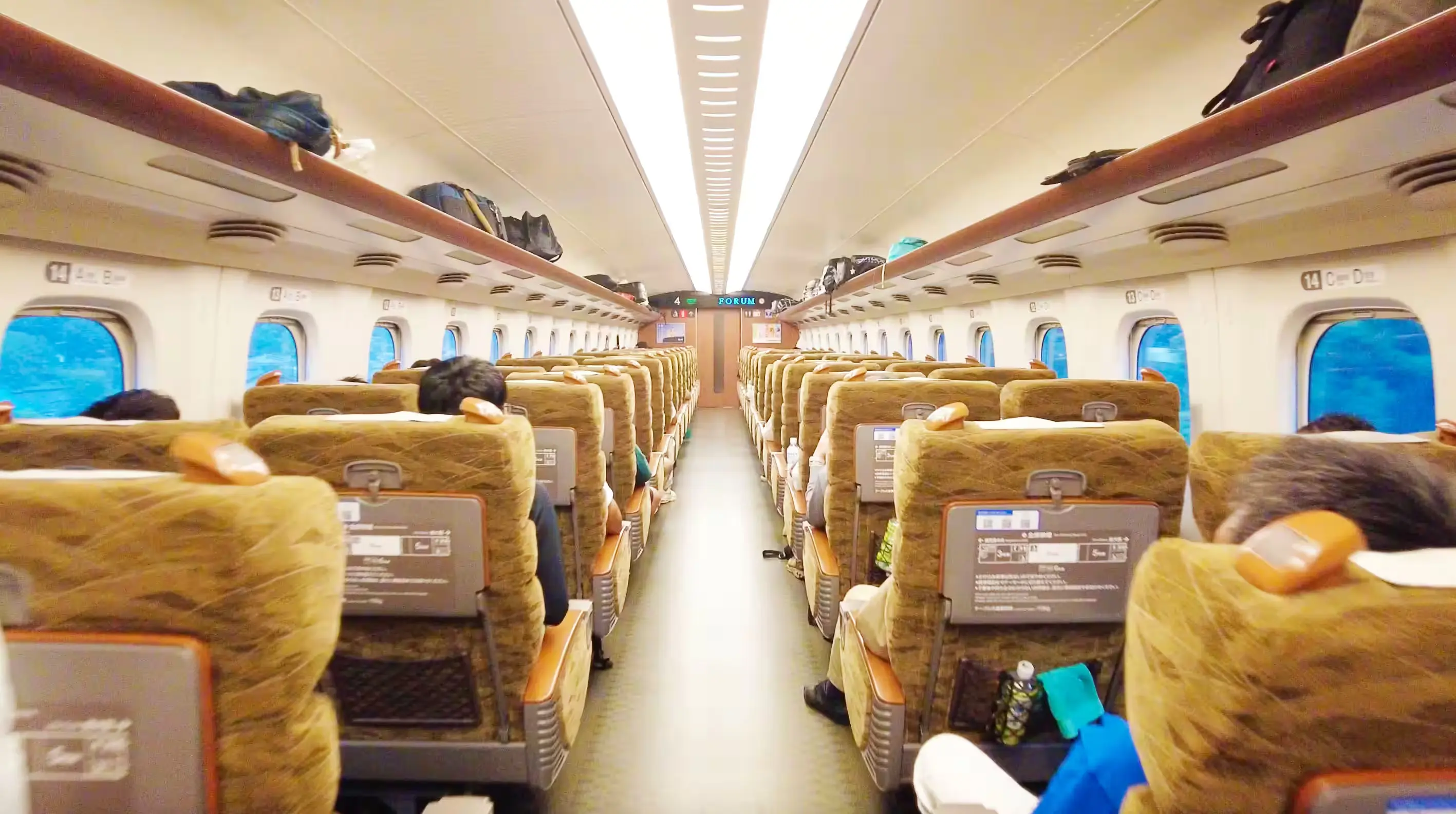
山陽新幹線 乗車記
- 時刻:10:23 →12:59 (約2時間36分)
- 航路:福岡(博多駅)→大阪(新大阪駅)
- 座席:指定席
- 料金:16,020円
車内放送:本日も新幹線をご利用いただきありがとうございます。
車内放送:まもなく終点、新大阪です。
放送後、通路には降車待ちの列ができ始めました。
新大阪駅に到着。
大阪駅までは快速電車で約4分(180円)。
都心部へのアクセスも良好です。
最後までお読みいただき、ありがとうございました!
山陽新幹線で運行されている列車
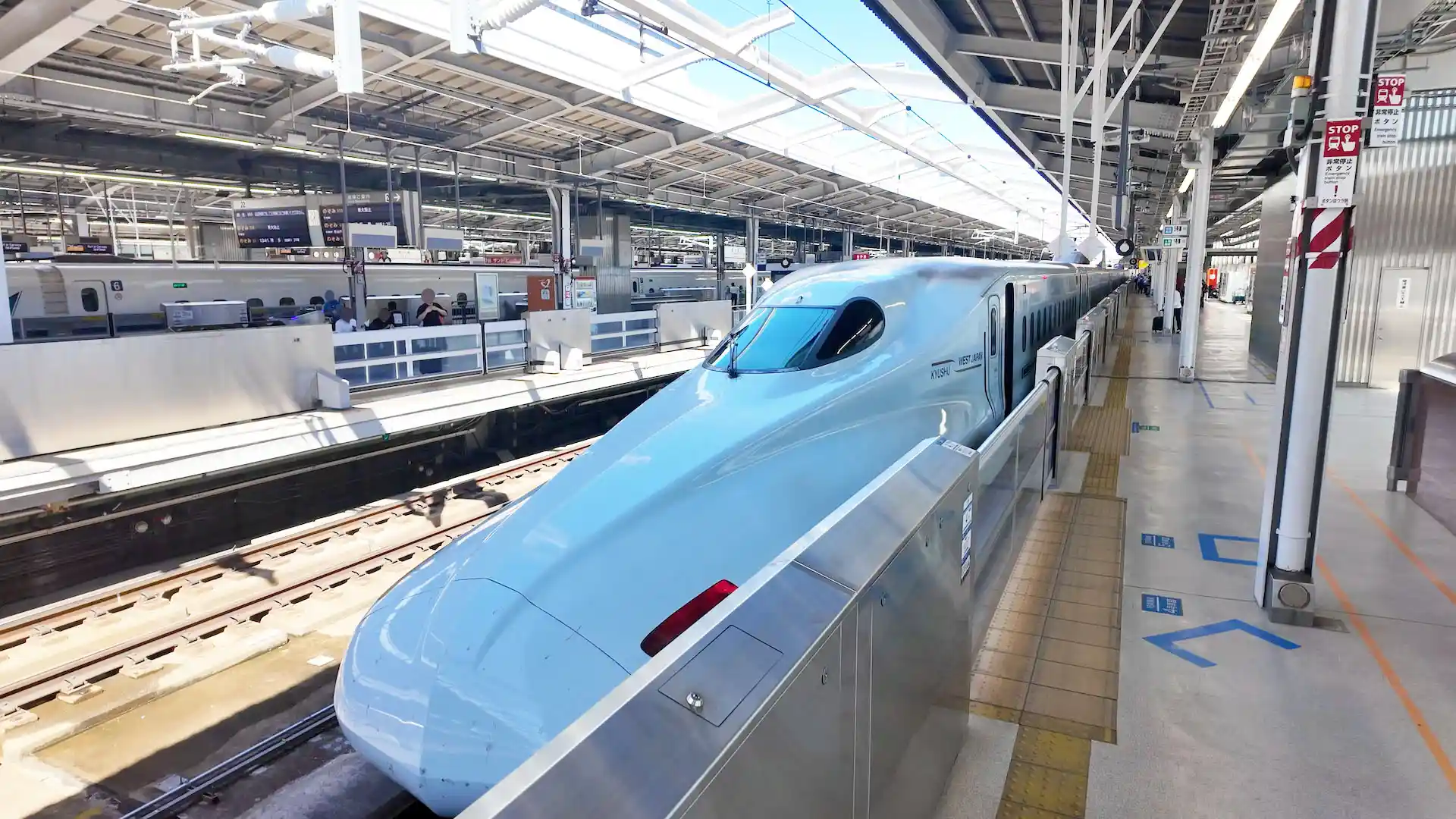
山陽新幹線の列車は、「みずほ」「のぞみ」「ひかり」「さくら」「こだま」の5種類。
新幹線には到着速度や路線、停車駅数に違いがあります。
今回は山陽新幹線の新大阪〜博多間に絞って、それぞれの特徴を簡単に紹介します。
| 列車名 | みずほ |
| 運行開始日 | 2011年3月12日 |
| 編成 | N700系(8両編成) |
| 全長 | 約200メートル(8両編成時) |
| 最高速度 | 300km/h |
| 定員 | 約600名(編成により異なる) |
| 停車駅(11駅) | 新大阪、新神戸、※西明石、姫路、岡山、福山、広島、※徳山、新山口、小倉、博多 |
| 列車名 | のぞみ |
| 運行開始日 | 1992年3月14日 |
| 編成 | N700系 / N700S系(16両編成) |
| 全長 | 約400メートル(16両編成時) |
| 最高速度 | 300km/h |
| 定員 | 約1,323名(N700系) |
| 停車駅(11駅) | 新大阪、新神戸、※西明石、姫路、岡山、福山、広島、※徳山、新山口、小倉、博多 |
| 列車名 | さくら |
| 運行開始日 | 2011年3月12日 |
| 編成 | N700系(8両編成) |
| 全長 | 約200メートル(8両編成時) |
| 最高速度 | 285km/h |
| 定員 | 約600名(編成により異なる) |
| 停車駅(13駅) | 新大阪、新神戸、※西明石、※姫路、※相生、岡山、福山、広島、※徳山、新山口、※新下関、小倉、博多 |
| 列車名 | ひかり |
| 運行開始日 | 1964年10月1日 |
| 編成 | N700系 / N700S系 (16両編成) |
| 全長 | 約400メートル (16両編成時) |
| 最高速度 | 285km/h |
| 定員 | 約1,323名(N700系) |
| 停車駅(13駅) | 新大阪、新神戸、※西明石、※姫路、※相生、岡山、福山、広島、※徳山、新山口、※新下関、小倉、博多 |
| 列車名 | こだま |
| 運行開始日 | 1964年10月1日 |
| 編成 | N700系 / N700S系(16両編成) |
| 全長 | 約400メートル (16両編成時) |
| 最高速度 | 285km/h |
| 定員 | 約1,323名(16両編成) |
| 停車駅(19駅) | 新大阪、新神戸、西明石、姫路、相生、岡山、新倉敷、福山、新尾道、三原、東広島、広島、新岩国、徳山、新山口、厚狭、新下関、小倉、博多 |
山陽新幹線 車内マップ
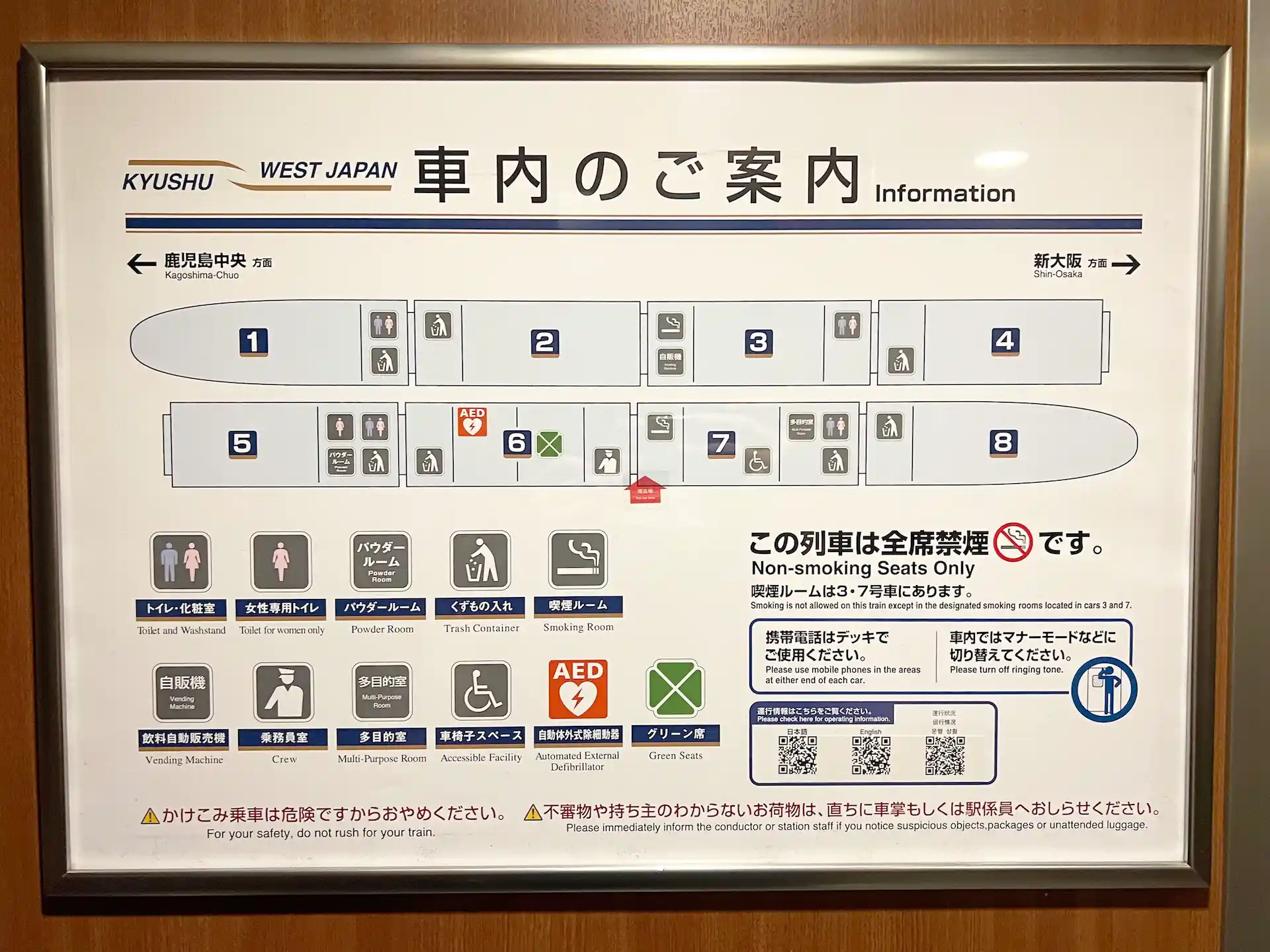
山陽新幹線 N700系の車内紹介
座席周辺(指定席)
コンセント
収納棚
洗面台
トイレ
山陽新幹線 予約方法・乗車券の購入方法
みどりの窓口
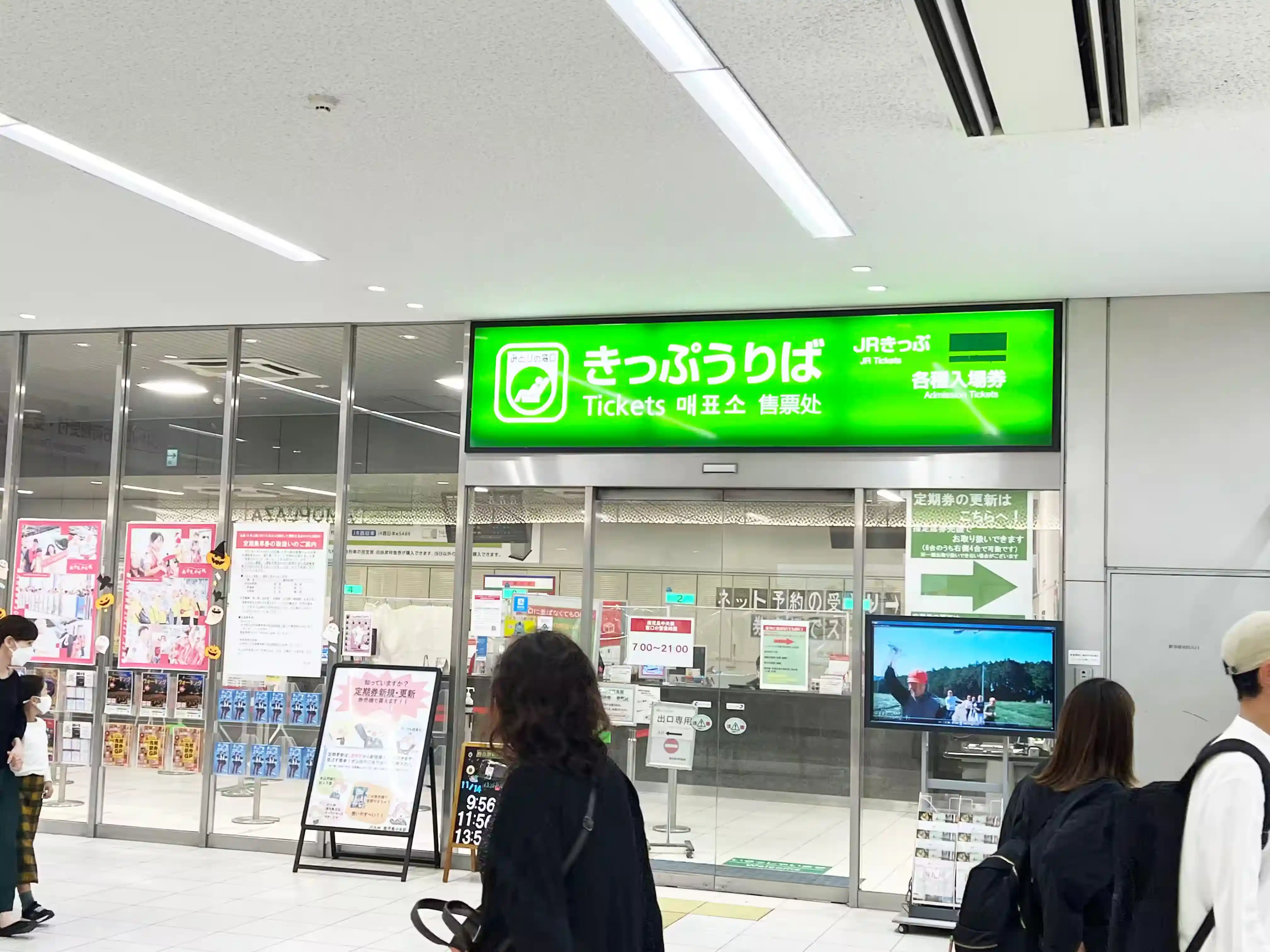
JRの特定エリアには「みどりの窓口」があります。
インターネットや代理店での購入が不安な場合は、ここでスタッフと相談しながら購入するのがおすすめです。
乗車予定日、人数、座席の種類(自由席・指定席)を伝えれば、スムーズにチケットを受け取れます。
みどりの券売機
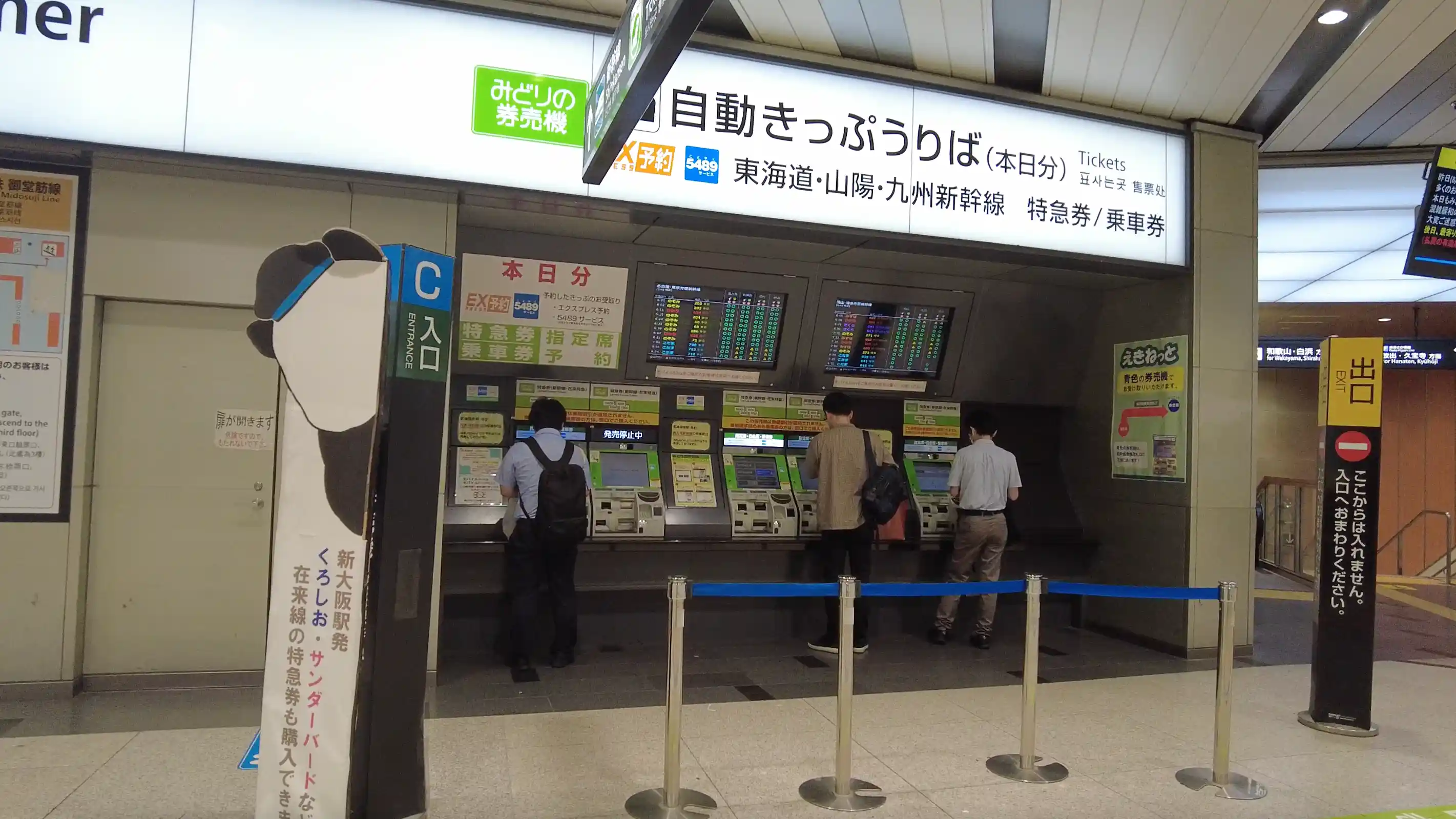
「みどりの券売機」は、新幹線のきっぷを無人で購入できる券売機です。
JRの指定駅にあります。
無人券売機「みどりの券売機」の使い方
- 「時刻検索からきっぷ購入」ボタンを押す
- 出発駅と到着駅を選択
- 利用日時を選択
- 乗車人数を選択
- 「希望の行程選択画面」で行程を選択
- 「特急券+乗車券を購入する」を押す
- 座席の種類を選択
- 車両を選択
- シートマップから好きな座席位置を選択
- 乗車券のタイプ「片道」「往復」を選択
- 現金もしくはクレジットカードを入れて乗車券を購入

インターネット予約
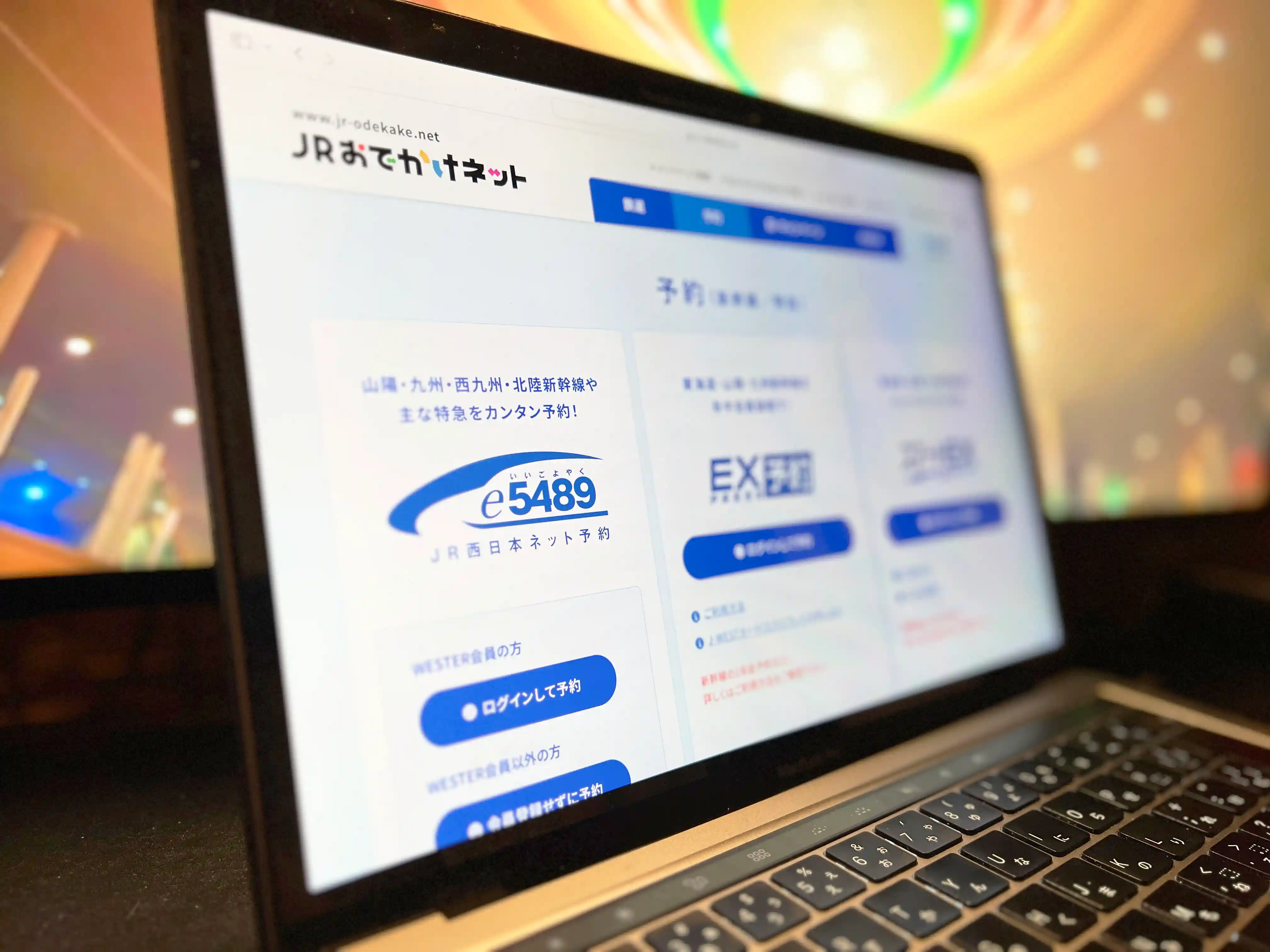
新幹線が予約できるサイトは5箇所。
予約時は出発地、目的地、列車の種類を確認しながら予約を進めます。
予約サイトのe5489では、乗車日の14日前から「スーパー早得きっぷ」の予約が可能です。慣れれば、インターネット予約後に当日、みどりの券売機で発券するのが理想的です。
旅行代理店で予約
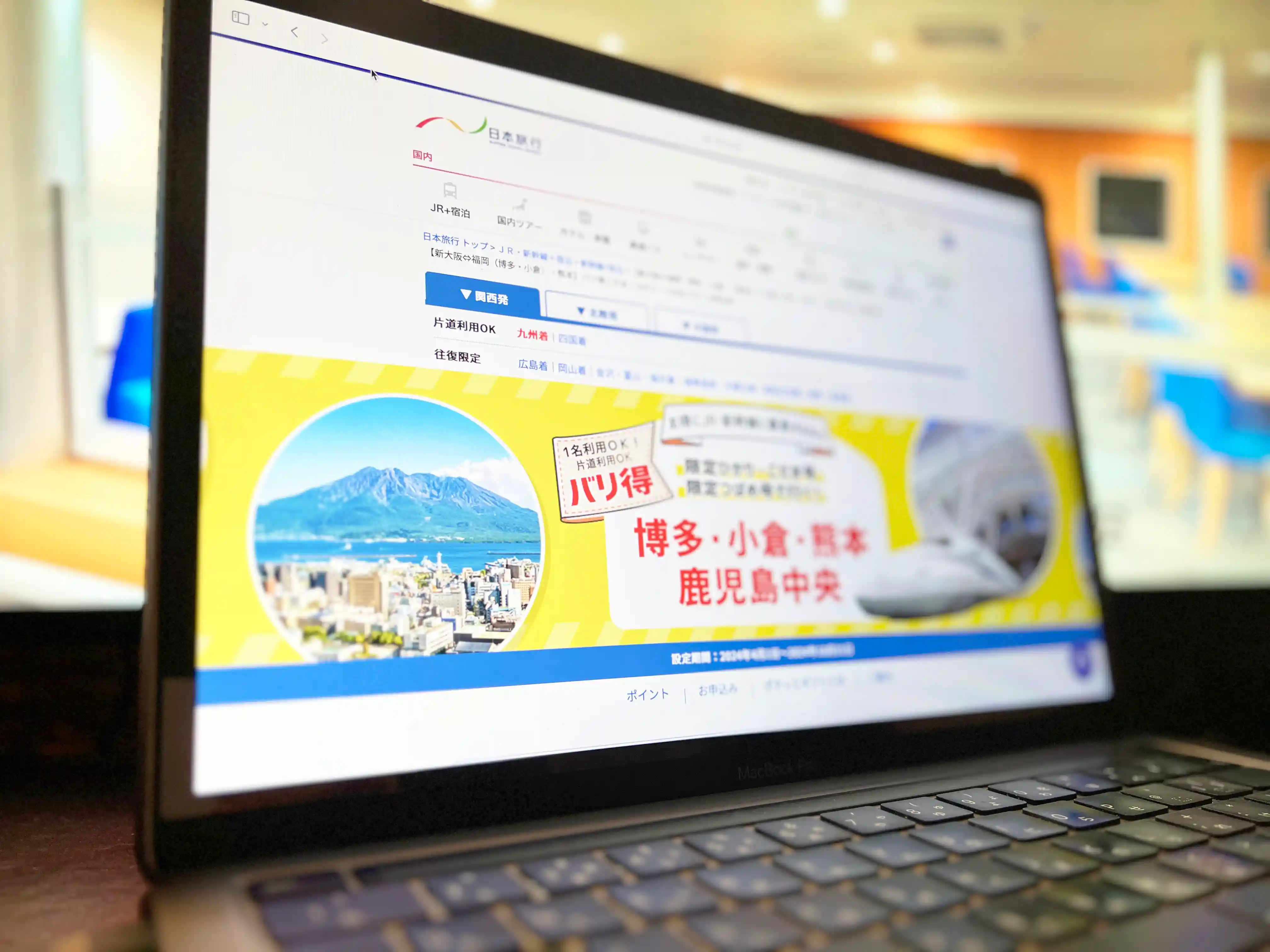
旅行代理店での購入は、とにかく安くチケットが手に入るのが魅力です。
インターネットの早割も安いですが、各駅停車の新幹線はさらに安く利用できます。
私が新大阪〜博多間で使った「こだま」のプランは、日本旅行の「バリ得こだま・ひかり・つばめで行くお得な旅」で、11,300円でした。
■新幹線「こだま」通常時とお得プランの料金比較
| 大人片道 | 料金 |
| 通常料金 | 15,480円 |
| 日本旅行のお得プラン | 11,300円 |
お得プランは通常より4,180円安く、指定席料金込みでかなりお得です。
ただし、「こだま」は各駅停車のため時間がかかります。
| 車両 | 区間 | 所用時間 |
| のぞみ・みずほ | 新大阪〜博多 | 約2時間28分 |
| こだま | 新大阪〜博多 | 約4時間30分 |
時間はかかりますが、旅行や帰省なら積極的に利用したいプランです。
山陽新幹線 乗車料金
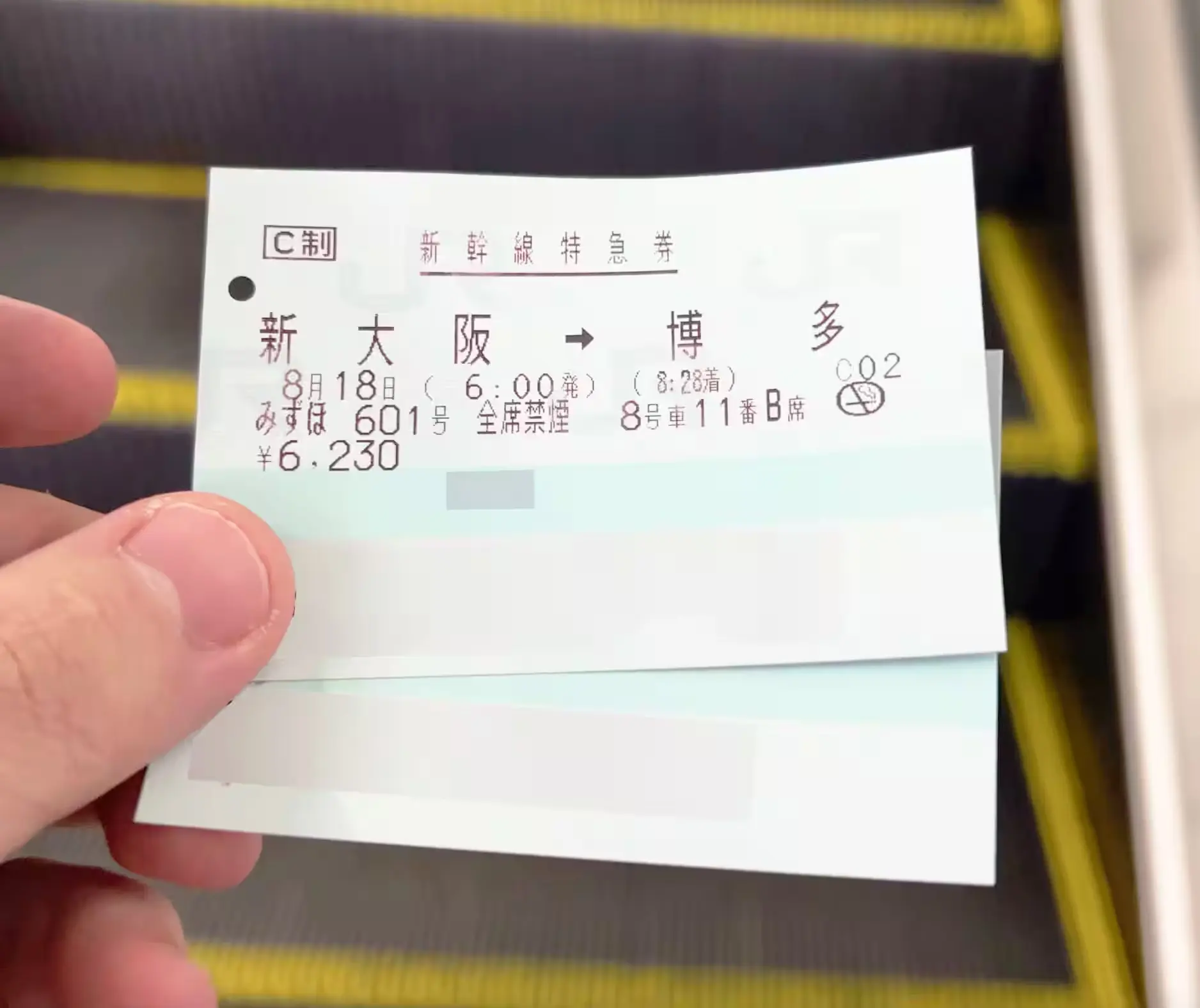
新大阪〜博多
| 座席 | 料金合計 | 乗車券 | 特急料金 |
| 自由席 | 14,750円 | 9,790円 | 4,960円 |
| 指定席 | 16,020円 | 9,790円 | 6,230円 |
| グリーン | 22,090円 | 9,790円 | 12,300円 |
| 座席 | 料金合計 | 乗車券 | 特急料金 |
| 自由席 | 14,750円 | 9,790円 | 4,960円 |
| 指定席 | 15,280円 | 9,790円 | 5,490円 |
| グリーン | 21,350円 | 9,790円 | 11,560円 |
| 座席 | 料金合計 | 乗車券 | 特急料金 |
| 自由席 | 14,750円 | 9,790円 | 4,960円 |
| 指定席 | 15,280円 | 9,790円 | 5,490円 |
山陽新幹線 座席の種類
山陽新幹線の車両には「自由席」「指定席」「グリーン席」の3種類があります。
自由席

自由席は新幹線で最も安く、時間を気にせず好きなタイミングで乗れるのが利点です。
みずほ号の自由席は青3列、赤2列の座席配置です。
ただし、繁忙期は座席が確実に確保できず、立つこともあります。
コンセントは車両の前後壁側に1つずつだけ。
窓側の席を取ると便利です。
指定席
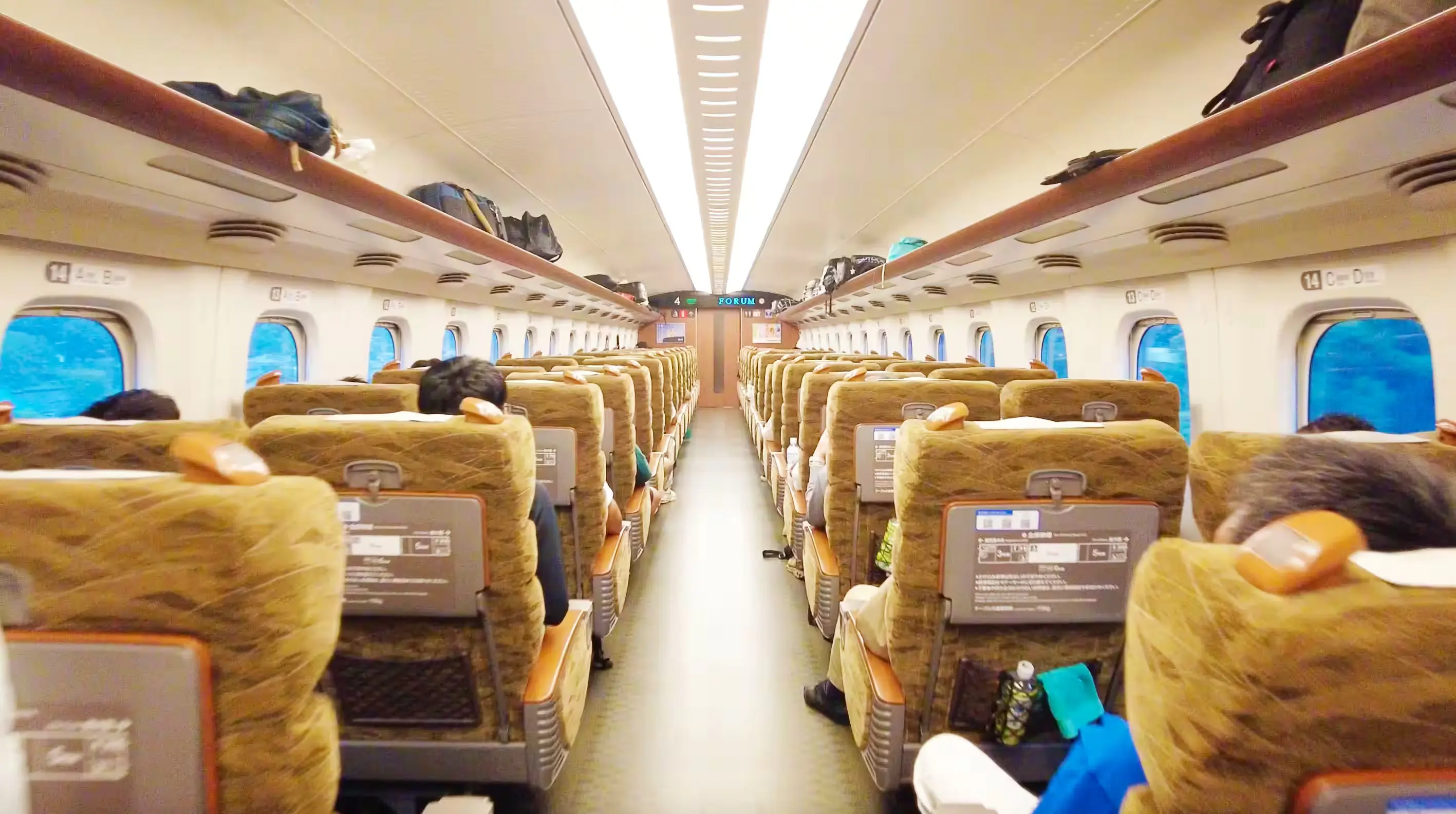
指定席は予約時に好きな席を選べます。
景色を楽しみたい方や混雑する時期(お盆や年末年始)に特におすすめです。
コンセントは自由席と同様に車両の前後壁側と各席の壁側に1つずつ。
窓側が便利ですが、通路側は出入りが楽なので好みで選びましょう。
特大荷物席
指定席車両には「特大荷物スペース付き座席」があります。
ベビーカー利用時や、大きな荷物(3辺合計160cm超〜250cm以内)がある場合におすすめです。
通常席では通路にはみ出してしまう恐れがあり、周囲の迷惑になることも。
特大荷物スペース付き座席を事前に予約しましょう。
※利用には1,000円の追加料金がかかります。
グリーン席
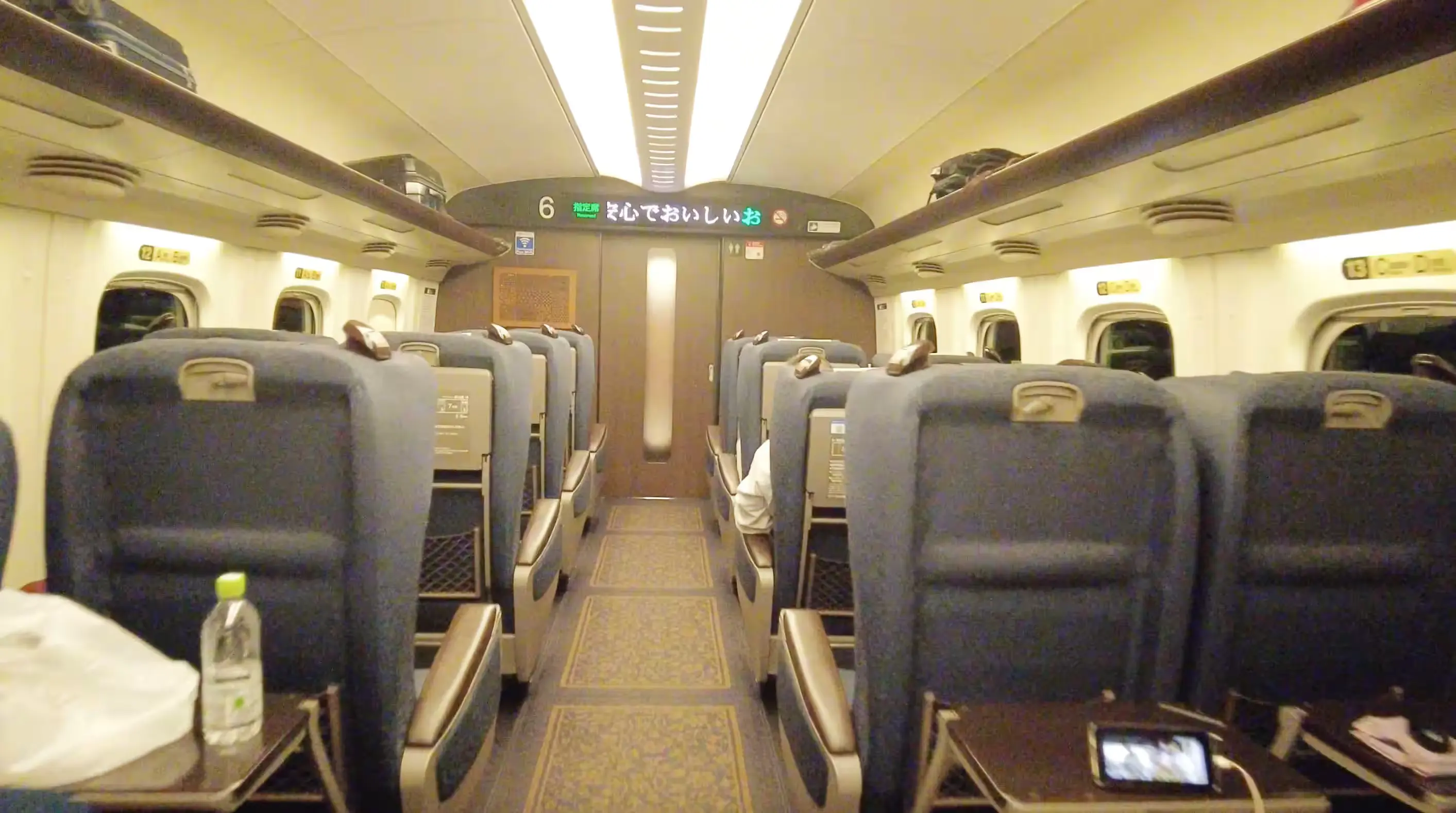
快適な座席と充実した設備
自由席・指定席のある車両に比べて、座席の幅が広く、前後の間隔にも余裕があるため、快適に過ごせます。
料金はやや高めに設定されていますが、その分ビジネスマンの利用が多く、静かで落ち着いた空間になっています。また、普通車にはない設備が充実しているのも魅力です。
主な設備
- フットレスト機能 や レッグウォーマー で足元も快適
- 肘掛け収納の折り畳みテーブル で作業がしやすい
- 一部座席では パーサー(客室乗務員) が おしぼりの提供 や 膝掛けのレンタル を実施
- 普通車よりやや 落ち着いた照明 で、読書灯 を使えば手元を明るくできる
さらに、各座席の肘置き先端部分にはコンセントが設置されているため、スマホやパソコンの充電にも便利。移動中に充電切れを気にせず作業できます。
山陽新幹線 改札の通り方
新幹線専用の改札口付近には、大きく「新幹線のりば」と表示されています。
通常のきっぷでは入場できず、新幹線用のきっぷが必要です。
改札機は青色で、スタイリッシュなデザインなのも特徴です。
きっぷの通し方
- 新幹線のきっぷを改札機に入れる
- 正常に読み取られると 緑色のランプ が点灯し、きっぷが出てくる
- きっぷを取って改札を通過

山陽新幹線 電光掲示板で乗車場所を確認する
新幹線の乗り場では、電光掲示板で出発時刻や乗り場番号を確認できます。
改札を通る前に、忘れずチェックしておきましょう。
山陽新幹線 よくある質問・Q&A
JR駅の券売機、みどりの窓口、オンライン予約(JR東海・JR西日本の公式サイト、スマホアプリ)から購入可能です。
はい、対応しています。紙の切符なしで乗車可能です。
切符は自動改札機に通すか、電子チケットならQRコードを改札端末にかざして通過します。
はい、別々に購入も可能ですが、まとめて購入すると便利です。
学割、早割きっぷ、往復割引、EX早特、スーパー早特きっぷなど多彩です。
はい、山陽新幹線のチケット予約・購入に対応しています。
自由席は先着順、指定席は座席が予約で確保されます。
グリーン車の特急券を追加購入すると利用可能です。
はい、自由席は当日購入も可能です。ただし混雑時は満席になることがあります。
■遅延時の対応(2時間以上の場合)
・特急料金(指定席・グリーンなど)は全額払い戻し対象
・到着が2時間以上遅れた場合、駅の窓口や精算所で手続きを。
・IC・QR券は自動返金も可能
・乗車券(運賃部分)は返金対象外。
・ただし、途中下車などで不要になった分は未使用区間の払い戻しが可能なこともあります。
・特急指定席を逃した場合、後続列車の自由席にそのまま乗車可。
東海道・山陽・九州新幹線の全車両で、無料の「Shinkansen Free Wi‑Fi」が利用可能です
ワイヤレスSSIDは「Shinkansen_Free_Wi‑Fi」。
メールアドレスやSNSアカウントでログインし、30分ごとに再接続が必要です 。
トンネルや山間部では電波が弱くなり、接続が途切れやすい点にご注意ください 。
【東海道・山陽新幹線の車内販売情報】
■グリーン車(のぞみ・ひかり)
・ワゴンによる車内販売あり
■普通車(みずほ・さくら・こだま)
・車内販売なし
【主なメニュー】
・サンドイッチ・弁当:ハムチーズ&たまご野菜サンド(460円、コーヒーセット割あり)
・アイス:超硬い新幹線アイス(バニラ360円/シャインマスカット450円)
・おつまみ:ミックスナッツ・明太さきいか 各380円、チップスター220円 など
・スイーツ:博多カステラ200円ほか
・限定フェア商品:ポルポローネ、大阪関西・岡山せとうち特産など
・飲料・セット:ビール、チューハイ、おつまみセットも販売
車内の座席や客室内での通話は禁じられていますが一部エリアで通話が可能です。
もし電話をする場合は、車両の連結部(デッキ)へ行くと通話ができます。
指定席は予約した時間に乗り遅れると無効になりますが、次の列車の自由席には乗車可能です。
乗り遅れても乗車券自体は無効にはなりません。
「みずほ」は普通車の指定席が2列+2列シート、「のぞみ」は普通車が全車2列+3列シートです。
「のぞみ」よりも「みずほ」の方が座席数が1つ少ない分、普通車の座席幅に余裕があります。
どちらも車両料金は同じなので、普通車を利用する方は「みずほ」がオススメです!
列車の愛称の違いもありますが、目的地までの速さも異なります。
■電車で例えた場合
みずほ – 快速
さくら – 準快速
■新大阪から博多駅までの平均所要時間の目安
みずほ – 2時間28分
さくら – 2時間39分
手荷物は大きさ制限内なら無料。特大荷物は事前申告が必要です。
持ち込み可能サイズ:縦・横・高さの合計 250cm以内、重さ 30kg以内/2個まで
合計 160cm以下:荷物棚や座席下に収納可能
特大荷物(160〜250cm)の場合
事前予約必須:「特大荷物スペース付き座席」または「特大荷物コーナー付き座席」を予約(追加料金不要)
予約せずに持ち込むと手数料 1,000円
・専用ケースが必須
顔が出るタイプやスリングは不可。全身が収まるケースを使用。
・サイズ・重量制限あり
ケースの3辺合計は120cm以内、ケース+ペットの総重量は10kg以内。
・料金は290円
「手回り品きっぷ」として1個につき290円が必要。
・置き場所に注意
座席下や荷物棚に置く。周囲の迷惑にならないよう配慮を。
※この情報は時点のものです。最新の情報とは異なる場合があります。
※内容の正確性や最新性は保証していません。ご利用は自己責任でお願いします。
※本サイトは情報提供を目的としています。内容やプラン、料金などは変更されることがありますので、必ず公式サイトで最新情報をご確認ください。
※外部リンク先の情報やプライバシーポリシーについては責任を負いません。
※著作権で保護されています。無断での転載・複製・配布は禁止です。
※免責事項は予告なく変更することがあります。
※本サイトの利用や、技術的な問題や中断による損害については責任を負いません。
※宗教や信仰に敬意を持ち、差別意図はありません。






















